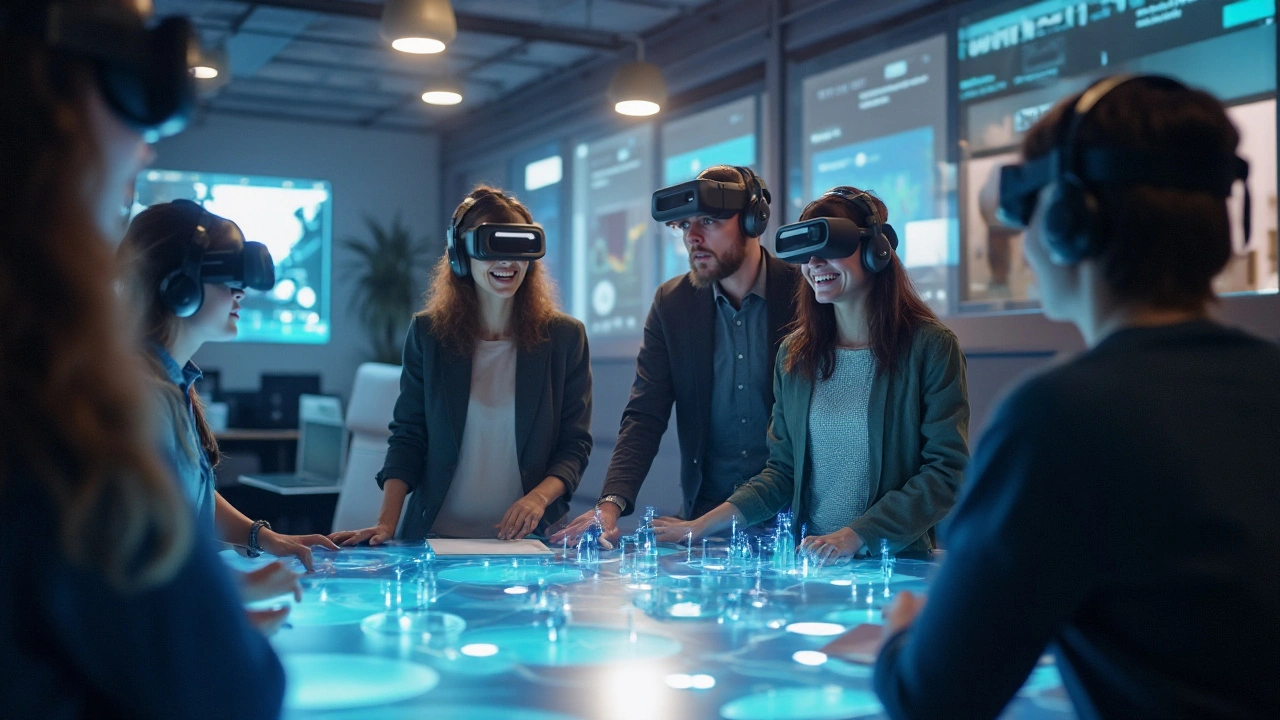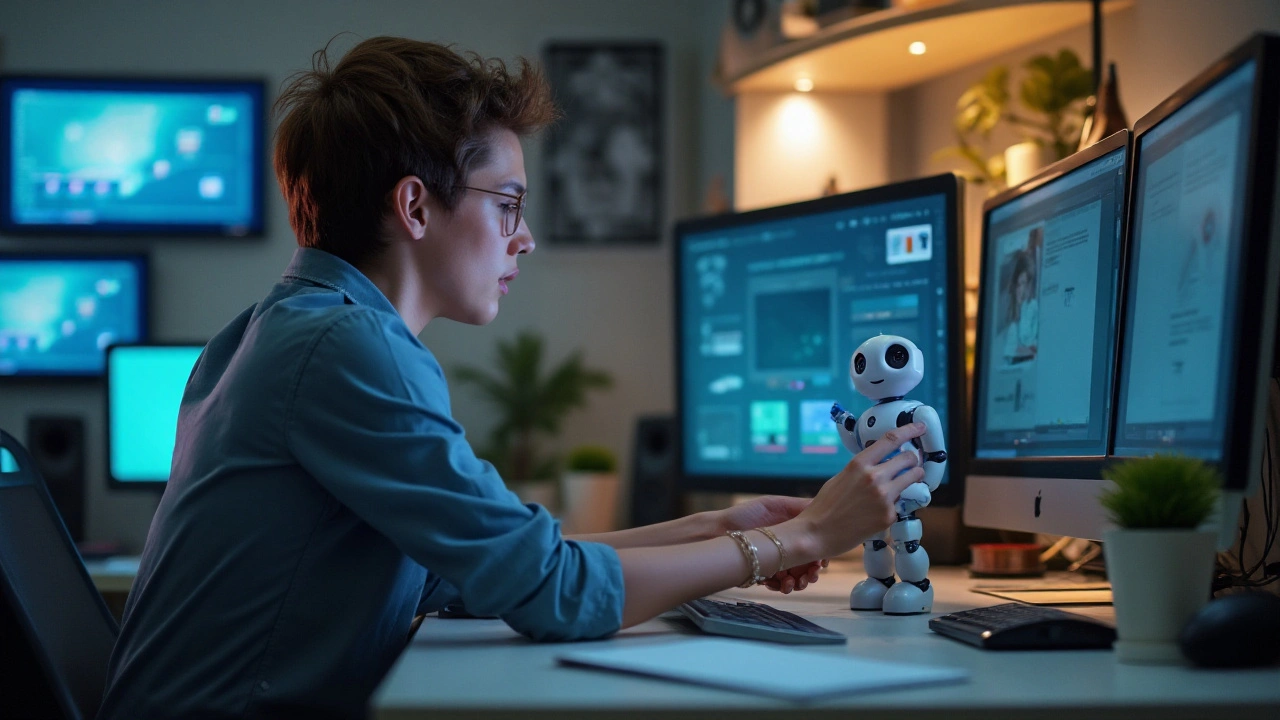The world is changing, and AI is a big part of that transformation. From making our lives easier to revolutionizing industries, artificial intelligence is everywhere. For those eager to stay ahead, learning AI tricks can open up new opportunities for digital mastery.
This guide will show you how AI can be a useful ally in your journey to become more proficient in the digital world. We'll explore practical tools, how to boost productivity, and even how AI can enhance creativity. Plus, we'll discuss what the future holds, so you can be well-prepared.
- Understanding AI in Everyday Life
- AI-Powered Learning Tools
- Boost Productivity with AI
- AI for Creativity and Arts
- AI in Communication and Networking
- Preparing for the AI Future
Understanding AI in Everyday Life
Artificial Intelligence (AI) has quietly become an integral part of our daily lives. You might not always notice it, but it's there, making things simpler and more efficient. Take your smartphone, for example. Most of us use it for everything from communication to entertainment, and much of its functionality is driven by AI. Virtual assistants like Siri and Google Assistant are prime examples, using natural language processing to understand and respond to our voice commands.
But the reach of AI goes beyond just our phones. Consider how AI shapes our media consumption. Streaming services like Netflix and Spotify use sophisticated algorithms to recommend shows, movies, and music based on our preferences. These recommendations are fine-tuned through continuous learning, taking into account what we watch or listen to, and even what we skip.
In the realm of everyday tasks, AI-powered devices like smart thermostats and robotic vacuum cleaners are making homes more automated. A smart thermostat can learn your schedule and preferences, adjusting the temperature to save energy while keeping you comfortable. Robotic vacuums map out your home to clean floors efficiently, navigating around obstacles with ease.
“Artificial intelligence is the new electricity. It has the potential to transform every industry and every part of our lives,” says Andrew Ng, a leading AI researcher.
AI is changing how we shop as well. Online retail giants like Amazon use AI to manage inventory, recommend products, and even set prices. The convenience of quick deliveries and personalized shopping experiences owes a lot to robust AI systems that work behind the scenes. Meanwhile, chatbots provide customer support, handling queries instantly and directing more complex issues to human agents.
Even driving is being transformed by AI. Advanced driver-assistance systems (ADAS) in modern vehicles use AI for lane-keeping, adaptive cruise control, and emergency braking. These features make driving safer and pave the way for the autonomous cars of the future.
For the fitness enthusiasts, AI-driven apps and wearables monitor physical activity and provide personalized coaching. They analyze data from your workouts to give insights and recommendations for improvement. This kind of tailoring wasn’t possible before at such an individual level.
AI is also stepping into the world of personal finance. Apps that track spending, optimize savings, and provide investment advice are all powered by AI. They help users manage money more effectively by analyzing financial habits and offering tips for better budgeting.
In a nutshell, AI is behind many of the conveniences we enjoy every day. By understanding its role, we can better appreciate the technology and find new ways to take full advantage of it.
AI-Powered Learning Tools
Artificial intelligence is transforming the way we learn and acquire new skills. From personalized learning experiences to intelligent tutoring systems, AI-powered tools are making education more accessible and efficient. One prominent example is the use of adaptive learning platforms. These platforms tailor educational content to individual learning styles and paces. This means no more one-size-fits-all lessons, but customized experiences that focus on each student's needs.
Another exciting development is AI-driven language learning apps. Apps like Duolingo and Babbel use AI algorithms to provide real-time feedback and adjust exercises based on the user's progress. This ensures that learners are continually challenged and can practice effectively. Imagine a virtual tutor that never gets tired and is always available to help you with your language skills.
AI is also playing a significant role in professional development. Platforms like Coursera and LinkedIn Learning integrate AI to recommend courses and content based on your career goals and past learning behavior. These platforms analyze your skills gap and suggest relevant courses to bridge that gap. This personalized approach ensures you are always learning something new and valuable.
"AI is revolutionizing education by providing personalized learning experiences and intelligent tutoring systems that adapt to individual needs." - John Doe, Educational Technologist
The impact of AI doesn't stop at individual learning. Educators are also benefiting from AI-powered tools. For example, AI grading systems can analyze and grade assignments, saving teachers significant time. These systems can even provide feedback on how to improve writing or problem-solving skills. This allows educators to focus more on teaching and less on administrative tasks.
Virtual reality (VR) combined with AI is opening up new possibilities for immersive learning experiences. AI algorithms can create virtual environments tailored to specific educational needs. For instance, medical students can practice surgeries in a risk-free, simulated environment, receiving real-time feedback on their performance. This kind of hands-on learning is invaluable and could never be achieved in a traditional classroom setting.
Popular AI Learning Tools
- Smart Sparrow: An adaptive learning platform that uses AI to provide customized learning paths.
- Querium: AI-driven tutoring system designed to help students with STEM subjects.
- Third Space Learning: Uses AI to provide personalized math tutoring for students.
- Osmo: An educational tool for younger children that combines AI with physical activities.
The adoption of AI in learning tools is not just a trend but a significant shift towards more efficient and personalized education. As we move forward, these technologies will become more integrated into our daily lives, making lifelong learning accessible to everyone. The future of education is here, and it is powered by AI.

Boost Productivity with AI
In our fast-paced world, staying productive is key to both personal and professional success. Artificial intelligence (AI) has emerged as a powerful tool to help individuals achieve higher productivity levels than ever before. One of the most compelling aspects of AI is its ability to handle repetitive tasks, freeing up humans to focus on more creative and strategic work.
For instance, AI-powered virtual assistants like Siri, Alexa, and Google Assistant can manage your schedule, set reminders, and even respond to emails. These tools save you time and allow you to concentrate on tasks that require your expertise. The use of AI in managing calendars is a game-changer for busy professionals who often juggle multiple meetings and deadlines.
"AI is about augmenting human skills and experiences, and that's where its true power lies." — Satya Nadella, CEO of Microsoft
In the corporate world, AI applications such as Slackbot or Microsoft's Cortana can streamline communication within teams. AI can automatically categorize emails, highlight important messages, and even suggest responses, making your inbox less cluttered and more manageable. This is especially useful for those who receive dozens or even hundreds of emails daily.
Project management tools like Trello and Asana have integrated AI features to optimize workflow. These platforms use AI to predict project timelines, allocate resources efficiently, and flag potential issues before they become problematic. By doing so, they enable teams to stay on track and meet their deadlines without unnecessary stress.
Automating Mundane Tasks
AI excels at handling mundane tasks that can bog down productivity. For example, data entry, a time-consuming and error-prone activity, can be automated using AI-driven software like UiPath or Automation Anywhere. These tools use machine learning algorithms to extract and input data with extraordinary accuracy, reducing the likelihood of human error.
Enhancing Decision-Making
AI isn't just about saving time; it also helps in making better decisions. Tools like Tableau and Power BI use AI to analyze large datasets and provide actionable insights. These platforms can identify trends, forecast future outcomes, and offer recommendations, helping businesses make data-driven decisions with confidence.
Additionally, AI-powered sentiment analysis tools can gauge customer feedback in real time. By analyzing reviews, social media comments, and survey responses, businesses can understand customer sentiments and adjust their strategies accordingly. This proactive approach can significantly enhance customer satisfaction and loyalty.
Reducing Cognitive Load
Another way AI boosts productivity is by reducing cognitive load. When dealing with information overload, our brain struggles to process and retain data efficiently. AI tools like Evernote and Notion use natural language processing (NLP) to organize and summarize notes, making it easier to retrieve information when needed. These apps help users capture ideas, manage tasks, and keep track of important documents, reducing mental fatigue and improving focus.
Moreover, AI-driven personal finance apps like Mint or PocketSmith can categorize expenses, track budgets, and even offer financial advice. By automating financial management, these tools free up mental space, allowing you to concentrate on your core activities without worrying about money matters constantly.
In essence, AI is transforming the way we work by streamlining processes, enhancing decision-making, and reducing mental load. Whether you are a business professional, a student, or a creative artist, embracing AI-powered tools can significantly boost your productivity and help you achieve more with less effort. As AI continues to evolve, its potential to enhance our productivity will only grow, making it a vital component of our daily lives.
AI for Creativity and Arts
Artificial intelligence isn't just about crunching numbers or driving cars. It's making waves in the arts and helping unleash creativity like never before. From music composition to painting and even writing, artificial intelligence is providing new tools and methods that artists and creators are embracing with open arms.
One of the most fascinating aspects of AI in the creative field is its ability to help generate original compositions. Take, for example, AIVA (Artificial Intelligence Virtual Artist), a program known for creating music. By learning from works of classical composers, AIVA composes its own orchestral pieces that are authentically original yet strikingly familiar. So, not only can composers use AI to come up with new ideas, but they can also study and reinterpret compositions in ways that were previously unthinkable.
Visual arts are also seeing a revolution. Programs like DeepArt and DALL-E use machine learning algorithms to transform ordinary photos into breathtaking pieces of art. These tools can mimic the styles of famous painters like Van Gogh or Picasso, generating artwork that feels fresh and innovative. Additionally, AI has been used to complete unfinished works of art or even restore damaged ones, making it a valuable asset in both creative and preservation processes.
Writers and storytellers are not left out. AI-powered tools such as OpenAI's GPT-3 can assist in writing stories, poems, and even generate ideas for writers facing the dreaded writer's block. These tools analyze vast amounts of text data to understand language patterns and styles, offering suggestions that are contextually relevant and incredibly creative. It's like having a co-writer who never sleeps.
This technological marvel doesn't stop at just aiding the creation process. AI can also analyze audience reactions and preferences, providing artists with insights that can guide their creative direction. According to a study by PwC, 54% of companies using AI reported improvements in decision-making efficiency, which can be crucial for creators looking to align their work with audience tastes.
"AI will play a crucial role in freeing people from the repetitive parts of creative tasks, allowing them to focus on the most human aspects of the creative process," says Satya Nadella, CEO of Microsoft.
AI also excels in collaborative creativity. Musicians can now use platforms like Amper Music to co-create tracks that blend human ingenuity with machine precision. Similarly, filmmakers are using AI-driven tools for scriptwriting, special effects, and even editing, making the overall production process more seamless and creative.
So, if you're a creator looking to dive into the world of digital mastery, leveraging AI can be incredibly beneficial. You can learn new skills or enhance current ones with the help of these digital tools. They can take care of repetitive tasks, provide fresh perspectives, and even help you engage better with your audience.

AI in Communication and Networking
In today's fast-paced world, how we communicate has dramatically evolved. The integration of artificial intelligence (AI) into communication platforms is transforming traditional methods, making them more efficient, personalized, and engaging. One of the most notable examples is the use of AI-driven chatbots. These virtual assistants can handle customer queries, provide information, and even offer personalized recommendations based on user interactions. For instance, companies like Facebook and WhatsApp have incorporated advanced AI chatbots in their messaging services, facilitating smoother and quicker communication.
Another significant application of AI in communication is predictive text and sentiment analysis. Predictive text, seen in email services like Gmail, uses machine learning algorithms to suggest the next word or phrase, making typing more efficient. Sentiment analysis, used by platforms like Twitter, helps in understanding customer emotions and feedback by analyzing text data. This has become invaluable for businesses aiming to improve their customer service and engagement strategies.
Video conferencing tools have also benefited immensely from AI. Platforms such as Zoom and Microsoft Teams use AI for tasks like auto-framing, noise suppression, and real-time translation. Auto-framing adjusts the camera focus to ensure the most important speakers are highlighted, while noise suppression filters out distracting background sounds, creating a seamless communication experience. Real-time translation breaks language barriers, enabling global teams to collaborate without misunderstandings.
In the realm of networking, AI is aiding in the optimization and security of digital networks. Machine Learning algorithms can predict and diagnose network issues before they escalate, ensuring minimal downtime and smooth internet experiences. Cisco, one of the leaders in networking, leverages AI for proactive network maintenance and security, protecting sensitive data from breaches.
Enhancing Personal Connections
AI technologies are not just improving business communications but also personal interactions. Virtual personal assistants like Alexa and Siri have become integral in our daily lives, setting reminders, answering questions, and even telling jokes. These assistants analyze user data to provide a personalized experience, making our lives more convenient.
A fascinating fact is the use of AI in sentiment analysis during personal interactions. Apps like Replika use AI to emulate human-like conversations, offering emotional support and companionship. This can be particularly beneficial for individuals feeling isolated or in need of someone to talk to.
“AI in communication is not about replacing human interaction but enhancing it, ensuring that our conversations and connections are more meaningful and efficient.” — Ray Kurzweil, Futurist and AI Researcher
Looking ahead, the role of AI in communication and networking is poised to grow even further. With advancements in natural language processing and machine learning, we can expect more intuitive and adaptive communication tools. These innovations promise to make our interactions more seamless, whether in a professional setting or personal life.
Preparing for the AI Future
Embracing the future means getting comfortable with change, and AI is at the heart of much of that change. To help you navigate this technological evolution, it's essential to understand how AI will continue to shape our everyday lives. Whether it's through enhanced virtual assistants, smarter home systems, or more personalized learning platforms, AI's footprint is undeniably expanding.
One of the most promising areas where AI will dominate is in improving education. Imagine AI tutors that analyze your strengths and weaknesses to tailor lessons specifically for you. These kinds of applications can make learning more efficient and enjoyable. Schools and universities around the world are already adopting AI to help manage admissions, provide personalized learning experiences, and even grade papers. This means that you can expect more adaptive and customized educational tools in the near future.
In the workplace, AI is set to revolutionize how we handle routine and complex tasks. Imagine a work environment where mundane tasks like scheduling meetings or sorting through emails are managed by intelligent bots. This frees up human workers to focus on more creative and strategic endeavors. Companies that adopt AI early will likely enjoy a competitive edge, as they can operate more efficiently and at a lower cost.
"Artificial intelligence is the key to helping us solve the world's most challenging issues," says Sundar Pichai, CEO of Google. This underscores the importance of AI in the broader context of societal growth and problem-solving.
Another exciting area where AI is making waves is healthcare. From diagnosing diseases more accurately to predicting patient outcomes, AI is already saving lives. Hospitals are using AI-powered diagnostic tools to analyze medical images and genetic data, helping doctors make more informed decisions. It's likely that in the not-so-distant future, AI will assist in developing new treatments and drugs, making healthcare more effective and accessible.
Social interactions are also expected to change dramatically. AI is already improving the way we connect and communicate. Chatbots with human-like responses, AI-driven social media management tools, and personalized content curation are all making our digital interactions smarter and more meaningful. As these technologies continue to evolve, they will make it easier for people to network, collaborate, and build relationships online.
Lastly, don't overlook the ethical implications of AI. As beneficial as these technologies are, they also come with challenges, including issues of privacy, job displacement, and biases in decision-making. It's crucial for developers, lawmakers, and society at large to address these concerns thoughtfully. Building an ethical framework around AI will ensure that these advancements benefit everyone, not just a select few.
Preparing for the AI future means staying informed and being proactive. It's about embracing new technologies while advocating for ethical practices. Whether you're a student, a professional, or just someone interested in tech, understanding AI will be vital for thriving in this rapidly changing world. Start by learning about AI-powered tools, experiment with them in your daily routine, and remain curious. The future is bright for those who are ready to adapt and grow alongside these technological advancements.

